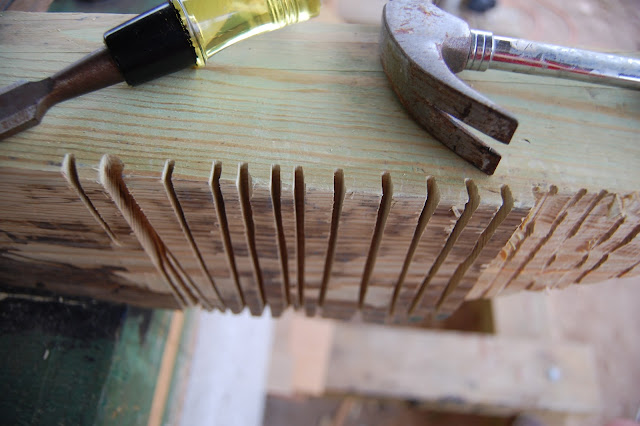 |
| Frame 5 is the first to go up! |
 |
| Treating bare wood with copper napthenate preservative. |
 |
| And she's up! Three 3/8" bolts on each side. All wood-to-wood contact surfaces were soaked with copper and bedded in tar. |
 |
| The "X" bracing and the cross beams at the sheer and just below the chine are temporary bracing. |
 |
| Not the neatest job, but she's strong and deadly to fungi. |
The first frame went up last night after a bit of a boat hiatus. Some coaxing with a Skillsaw and chisel got the frame to where it was supposed to hit the rabbet. It's nearly plumb, too. I apparently did a horrible job installing the floors, as three or four of them are not plumb nor flush with the station lines drawn on the keel. I'll be spending a lot of time over the next few days correcting my mistakes with a plane. This part of the boat building process has become tense as I anticipate bending a batten around the chine for the first time. I hope Luna will be beautiful.
Lucky for me, the universe sent me an auspicious sign this morning to calm my nerves.
I woke up at about 4 am this morning to a smelly, wet substance on my arm. I flung on the lights and, without my glasses, saw a blurry yellow puddle with a long, black swirly piece of business on my sheets where my arm had been. My mind immediately thought rats!, as I do have a history of sleeping in places were rats attack me in the night. Given this, and the series of rabies shots that followed, I am deathly afraid of rodents. I decided that, judging from the size of the mess on my bed, this rat had to be HUGE. I frantically called Ramon to come over.
When I went back into my bedroom the turd was gone! I decided the rat must have come back and eaten it. I freaked. I had a monstrous, poo-eating rat in my bedroom. I noticed a dark blurry mass moving slowly toward the corner of my bed. Rather than get closer, I decided to get out of there and start doing internet searches for, "feces consumption in rats," worried that there was a correlation between this behavior and rabies. Very productive.
When Ramon arrived, bleary-eyed and sweet as could be, we searched my bedroom with no luck. Ramon suggested the turd was in fact a culebrilla and that there was no rat. I was somewhat comforted by this possibility.
 |
| Culebrilla-- apparently common in the Valley, though sightings are rare. |
But still-- the smelly yellow stuff made no sense. I resorted to Googling things like, "fat worm smelly yellow liquid" and finally came up with this:
A giant millipede! When stressed or injured, they secrete a pungent yellow substance that contains hydrogen cyanide. We never did find it, and these things live for 5-10 years. There was a lot of yellow stuff though, so one can hope it was fatally wounded. Ah well. Despite the long-lived monster spewing cyanide in my bedroom, I did sleep a little sounder knowing it wasn't a rat.
The the silver lining in this early-morning fiasco? Apparently millipedes are good luck. Perhaps the chine will be fair after all.

















